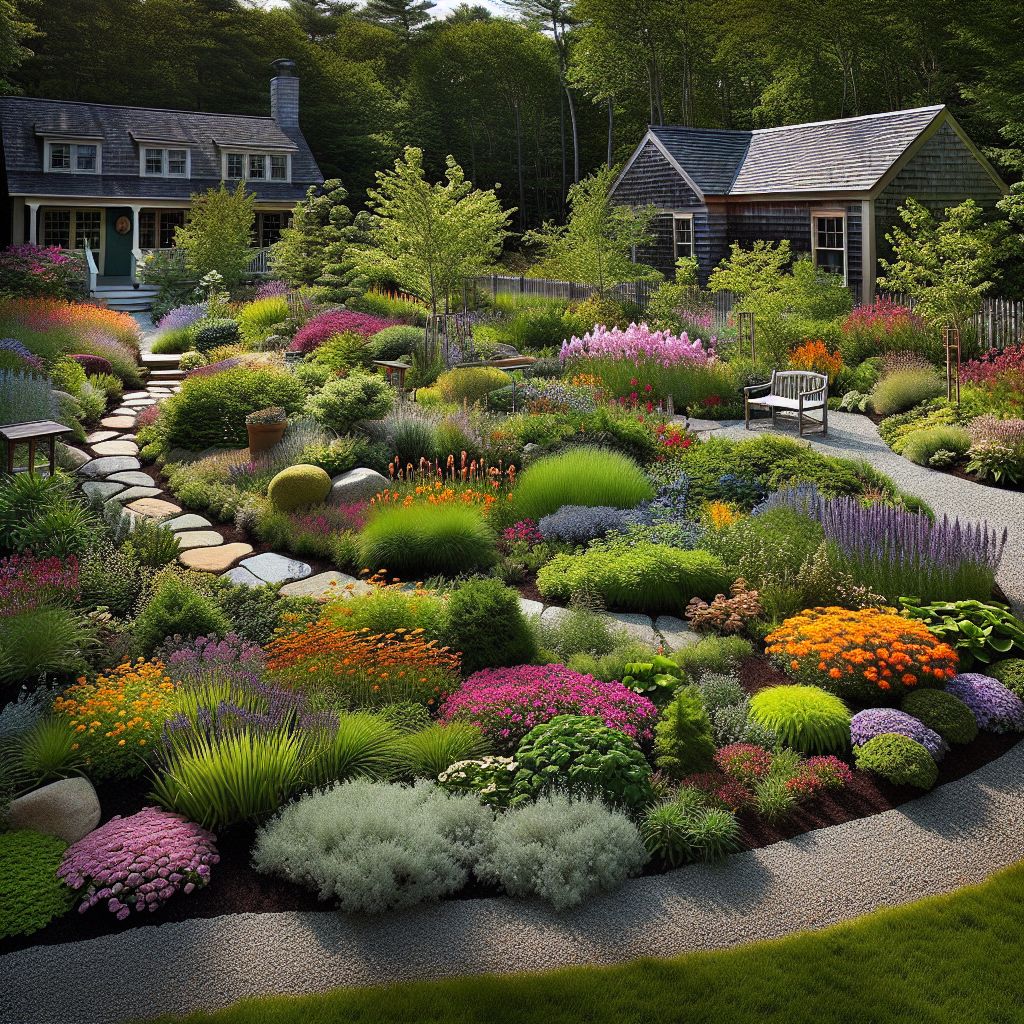
Key Takeaways
- Xeriscaping is a gardening philosophy that focuses on water conservation through the use of native plants and efficient landscaping techniques.
- Native plants like Purple Coneflower and Black-eyed Susan are perfect for Wisconsin
because they’re adapted to local conditions and require less maintenance. - You can create a cohesive and water-efficient garden layout by understanding your yard’s microclimates.
- Proper soil preparation and strategic irrigation are key to establishing a thriving xeriscape garden.
- Xeriscaping is not only about reducing water usage; it also involves seasonal maintenance to ensure your garden’s long-term health and beauty.
Transform Your Garden with Wisconsin Xeriscaping
Imagine entering your garden and being greeted by a vibrant tapestry of native flowers, grasses, and shrubs that thrive with minimal care and water. This is the essence of xeriscaping, a sustainable landscaping approach perfect for Wisconsin’s varied climate. Let’s explore how you can transform your yard into a beautiful, low-maintenance haven that respects the local ecosystem and conserves precious resources.
What Is Xeriscaping?
Xeriscaping is a landscaping method that reduces or eliminates the need for supplemental water from irrigation. It’s especially beneficial when water is scarce, or conservation is a priority. The term ‘xeriscape’ comes from the Greek word ‘xeros,’ meaning dry, and ‘scape,’ referring to the view or scene. So, xeriscaping creates a “dry scene” in your garden that relies on plants with low water requirements.
Why Choose Native Plants for Your Yard?
Choosing native plants for your xeriscape garden is crucial. These plants have evolved to thrive in Wisconsin’s specific climate, soil types, and environmental conditions. This means they are naturally more resistant to local pests, diseases, and weather extremes. Most importantly, they require far less water and care than non-native species, making them the ideal candidates for a sustainable garden.
Moreover, native plants support local wildlife, providing habitat and food for birds, bees, butterflies, and other beneficial creatures. By choosing native plants, you’re creating a low-maintenance yard and contributing to the health and diversity of the local ecosystem.
Native Plants Perfect for Wisconsin Xeriscaping
Wisconsin’s native flora offers a wide range of xeriscaping options. Here are some stellar plants that can handle the cold winters and hot summers while keeping your garden’s water use to a minimum:
Prairie Dropseed: An Elegant Grass
Prairie Dropseed (Sporobolus heterolepis) is a graceful, clumping grass that adds a touch of elegance to any garden. It’s known for its fine-textured foliage and delightful fragrance. Come autumn, its leaves turn a golden hue, providing year-round interest.
Butterfly Milkweed: A Magnet for Pollinators
- Drought-tolerant once established, requiring minimal watering.
- Produces vibrant orange flowers that are a favourite of butterflies, especially monarchs.
- Thrives in full sun and well-drained soil, making it a versatile choice for sunny spots in your yard.
Butterfly Milkweed (Asclepias tuberosa) is beautiful and plays a critical role in the lifecycle of monarch butterflies. Its bright blooms attract a variety of pollinators, making it an excellent choice for an eco-friendly garden.
Now, let’s focus on how to bring your low-water garden to life. This involves selecting the right plants, understanding the unique aspects of your garden space, and arranging your plants for the best results.
Designing Your Low-Water Wisconsin Garden
Designing a beautiful and water-efficient garden starts with a good plan. You’ll want to consider factors like sunlight, soil type, and how water moves through your yard. A well-designed xeriscape garden minimizes water use while maximizing the natural beauty of your outdoor space.
Understanding Your Yard’s Microclimates
Every yard has microclimates—small areas that differ in light, wind, and moisture. Observe your yard throughout the day to make the most of these conditions. Notice where the sun shines the longest and where shade lingers. These observations will guide you in placing plants in areas where they will thrive naturally, reducing the need for extra water and care.
Creating a Cohesive Plant Layout
With various native plants at your disposal, you can create a stunning and cohesive garden layout. Group plants with similar water needs together; this technique, called hydrozoning, makes watering more efficient. Start with the larger plants like shrubs and trees, then fill in with smaller perennials and groundcovers to create a full, layered look.
Wisconsin Xeriscaping: Native Plants
| Native Plant | Description |
|---|---|
| Black-eyed Susan (Rudbeckia) | Drought-tolerant, attracts butterflies and bees, blooms from June to September. |
| Purple Coneflower (Echinacea) | Resistant to disease and pests, attracts pollinators, blooms from July to September. |
| Wild Bergamot (Monarda) | Attracts hummingbirds and butterflies, blooms from June to September, and has a pleasant citrus scent. |
| Little Bluestem (Schizachyrium) | Drought-tolerant, low-maintenance, and provides a naturalistic landscape appearance. |
| Butterfly Milkweed (Asclepias) | Attracts monarch butterflies, blooms from June to August, and is a vital food source for caterpillars. |
References:
- Bogleheads.org – Creating the Lowest Possible Maintenance Yard
- A Guide to Selecting Landscape Plants for Wisconsin (A2865)
- LawnStarter – 21 Native Plants for Wisconsin
- Bob Vila – Drought-Tolerant Landscaping Ideas for a Low-Water Yard

Today’s Decisions, Tomorrow’s Beauty
When you’re planning a xeriscape garden, you’re making decisions that will shape the future of your outdoor space. The steps you take today to prepare your garden will pay off in the beauty and ease of maintenance of your yard in the coming years.
Soil Prep: The Foundation of a Thriving Garden
The success of your xeriscape starts with the soil. Most native plants prefer well-drained soil, so if yours is heavy clay or sand, you’ll need to amend it. Adding organic matter like compost can improve soil structure, helping it retain moisture while also draining well. Remember, healthy soil means healthy plants, which translates to less watering and maintenance in the long run.
Irrigation Tips: When Less Means More
Efficient watering is key to xeriscaping. Drip irrigation systems are ideal because they deliver water directly to the plant roots, reducing waste. If you’re using sprinklers, water early in the morning to minimize evaporation. And always adjust your watering schedule based on rainfall; after all, every drop counts!
Year-Round Care for Your Xeriscape Oasis
Even low-maintenance gardens need some care. The good news is that xeriscaping tasks are less frequent and often easier than with traditional landscaping.
As the seasons change, so do your garden’s needs. Here’s what to keep in mind throughout the year: consider xeriscaping with native plants for a low-maintenance and sustainable approach.
Spring: This is the time for mulching and adding compost to beds to conserve moisture and suppress weeds. It’s also a good time to prune any winter damage from your plants.
Summer: Keep an eye on your garden’s moisture levels, especially during hot, dry spells. Water if necessary, but remember that native plants are designed to handle some drought.
Fall: Plant new additions to your garden now, so they have time to establish roots before winter. Cut back perennials as they die back, and consider leaving seed heads for birds.
Winter: Your garden may be dormant, but you can still plan for the next season. This is a great time to design new garden areas or make changes to existing ones.
Seasonal Maintenance: What to Do When
Your xeriscape garden will have different maintenance needs with each season. In the spring, focus on cleaning up any debris and refreshing mulch. During the summer, monitor your plants for signs of stress and water sparingly if needed. Prepare your garden for winter in the fall by cutting back perennials and protecting young plants with extra mulch. Winter is a time for rest and planning, as you dream up new additions or changes for the coming year.
Long-Term Rewards: Watching Your Garden Flourish
As you tend to your xeriscape garden over the years, you’ll be rewarded with a dynamic, resilient space that grows more beautiful with time. You’ll see the benefits of your choices in the thriving plants, the vibrant ecosystem, and the reduced water bills. Embrace the journey, knowing that with each season, you’re contributing to a healthier planet in your backyard.

FAQ: Native Plants for Low Maintenance Xeriscaping Yards in Wisconsin
How Does Xeriscaping Conserve Water?
Xeriscaping conserves water primarily by utilizing plants that are naturally adapted to the local climate and soil conditions. These plants require less water than non-native or high-need plants. Efficient design, such as grouping plants with similar water needs and using mulches to reduce evaporation, also contributes to water conservation.
Additionally, xeriscaping often employs irrigation techniques like drip systems that deliver water directly to the plant roots, minimizing waste. By carefully selecting plants and planning your garden layout, you can significantly reduce the need for supplemental watering, even during dry spells.
Which Native Plants Are Best for Full Sun in Wisconsin?
In Wisconsin, full sun areas of your garden can support a variety of native plants. Here are some top performers:
- Purple Coneflower (Echinacea purpurea): Known for its striking purple blooms and resilience in hot, sunny spots.
- Black-eyed Susan (Rudbeckia hirta): Features bright yellow flowers stapled in sunny Wisconsin gardens.
- Wild Bergamot (Monarda fistulosa): This plant offers
flowers and a pleasant fragrance. It attracts pollinators and thrives in full sun.
These plants withstand full sun conditions and add vibrant colour and texture to your xeriscape garden while requiring minimal extra care.
Can Xeriscaping Really Reduce Yard Maintenance?
Yes, xeriscaping can significantly reduce yard maintenance. By selecting drought-tolerant native plants and using mulches to suppress weeds and retain soil moisture, you’ll spend less time watering, weeding, and dealing with pest problems. This low-maintenance approach gives you more time to enjoy your garden rather than laboring over it.
Keep in mind, though, that some maintenance, such as occasional pruning and seasonal cleanup, is still necessary to keep your xeriscape looking its best.
Is Xeriscaping Suitable for Cold Wisconsin Winters?
Wisconsin’s winters can be harsh, but xeriscaping with native plants is well-suited to withstand the cold. Native plants are acclimated to local weather patterns, including freezing temperatures and snowfall. With proper selection and placement, these plants will go dormant in winter and return with vigour in the spring.
To protect your xeriscape during winter, consider applying a layer of mulch to insulate plant roots and pruning back perennials after the first frost to help them conserve energy.
How to Get Started with Designing a Xeriscape Yard?
Starting a xeriscape yard begins with research and planning. Familiarize yourself with native plants and their requirements. Sketch a map of your yard, noting areas of sun and shade, dry spots, and soil types. Group plants with similar needs together and consider incorporating elements like rocks or pathways to reduce water-dependent turf areas.
Consult with local nurseries or extension services for advice, and start small. You can gradually expand your xeriscape as you gain confidence and experience with your unique garden space’s best plants and techniques.




Leave a Reply